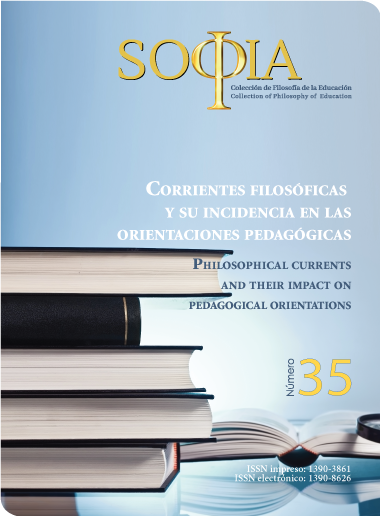Education, writing and existence in Miguel de Unamuno
Main Article Content
Abstract
Article Details

This work is licensed under a Creative Commons Attribution-NonCommercial-ShareAlike 4.0 International License.
Authorship: The list of authors signing must include only those people who have contributed intellectually to the development of the work. Collaboration in the collection of data is not, by itself, a sufficient criterion of authorship. "Sophia" declines any responsibility for possible conflicts arising from the authorship of the works that are published.
Copyright: The Salesian Polytechnic University preserves the copyrights of the published articles, and favors and allows their reuse under the Creative Commons Attribution-NonCommercial-ShareAlike 3.0 Ecuador license. They may be copied, used, disseminated, transmitted and publicly displayed, provided that: i) the authorship and the original source of their publication (journal, editorial and work URL) are cited; (Ii) are not used for commercial purposes; Iii) mention the existence and specifications of this license.
References
Álvarez Castro, Luis. (2005) La palabra y el ser en la teoría literaria de Unamuno. Salamanca: Ediciones Universidad Salamanca.
Cerezo Galán, Pedro. (1996) Las máscaras de lo trágico.Valladolid: Editorial Trotta
Olson, Paul. (1970-1971). “Cómo se hace una novela, Unamuno>”. Revista Hispánica Moderna. Año 36, No. 4, pp.186-199
Tanganelli, Paolo. (1998). “Los cuadernillos de Unamuno anteriores a la etapa socialista y la crisis del racionalismo” Cuadernos de la Cátedra Miguel de Unamuno.No. 33, pp. 95-112
Unamuno, Miguel de. (1958). Obras completas de Unamuno, Tomo III. Madrid. Vergara S. A.
_________________________________________________, Tomo V. Madrid. Vergara S. A.
_________________________________________________, tomo VII. Madrid. Vergara S. A.
_________________________________________________, tomo IX. Madrid. Vergara S. A.
_________________________________________________, tomo X. Madrid. Vergara S. A.
_________________________________________________, Tomo XIII. Madrid. Vergara S. A.
Unamuno, Miguel de. (1999). “La razón y la imaginación”. En Escritos bilbainos (1879-1894). Bilbao.
Unamuno, Miguel de. (2017). “Carta No. 152”, a Francisco Fernández Villegas, 12 de noviembre de 1896, en: M. de Unamuno, Epistolario I. Salamanca. Universidad de Salamanca.
Unamuno, Miguel de. (2017). “Carta No. 155”, a Francisco F. Villegas, 28 de noviembre de 1896, en: Miguel de Unamuno, Epistolario I. Salamanca. Universidad de Salamanca.
_______________________ . “Carta No. 146”, a Pedro de Múgica, 17 de mayo de 1896, en: Miguel de Unamuno, Epistolario I. Salamanca. Universidad de Salamanca.
Unamuno, Miguel de. (2016). “Notas entre Madrid y Bilbao, Cuaderno III”, Cudernos de juventud. Salamanca. Universidad de Salamanca.
________________________. “Cuaderno V”, Cudernos de juventud. Salamanca. Universidad de Salamanca.
________________________. “Cuaderno XVII”, Cudernos de juventud. Salamanca. Universidad de Salamanca.
Unamuno, Miguel de. (1995) “Velada infantil”. En Prensa Juventud. Madrid. Compañía Literaria.
Unamuno, Miguel de. (1995). “Los preceptos de la ley del maestro de escuela”. En Prensa Juventud. Madrid. Compañía Literaria.
Unamuno, Miguel de. (2016) “Filosofía II”. En Cuadernos de la juventud. Ed. Miguel Ángel Rivero Gómez. Salamanca. Ediciones de la Universidad de Salamanca.
Unamuno, Miguel de. (2017). “Don Sandalio, jugador de ajedrez”. En J.A. Garrido. (Ed.) Novelas completas. Madrid. Catedra.
________________________. “Amor y Pedagogía”. En J.A. Garrido. (Ed.) Novelas completas. Madrid. Catedra.
Unamuno, Miguel de. (1993). “Las noticias” de Barcelona (1899-1902). En A. Sotelo Vázquez. Barcelona. Lumen.
Unamuno, Miguel de. (1998). Alrededor del Estilo. Salamanca. Universidad de Salamanca.

